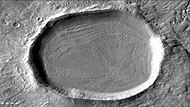Concentric crater fill
A concentric crater fill (CCF)[1] is a landform where the floor of a crater is mostly covered with many parallel ridges.[2] It is common in the mid-latitudes of Mars,[3][4] and is widely believed to be caused by glacial movement.[5][6] Areas on Mars called Deuteronilus Mensae and Protonilus Mensae contain many examples of concentric crater fill.
Description[]
Concentric crater fill, like lobate debris aprons and lineated valley fill, is believed to be ice-rich.[7] Sometimes boulders are found on concentric crater fill; it is believed they fell off the crater wall, then were transported away from the wall with the movement of the glacier.[8][9] Erratics on Earth were carried by similar means.
High resolution pictures taken with HiRISE reveal that some of the surfaces of concentric crater fill are covered with strange patterns called closed-cell and open-cell brain terrain. The terrain resembles a human brain. It is believed to be caused by cracks in the surface accumulating dust and other debris, together with ice sublimating from some of the surfaces. The cracks are the result stress from gravity and seasonal heating and cooling.[10][11]

Closed-cell brain terrain, as seen by HiRISE under the HiWish program. This type of surface is common on lobate debris aprons, concentric crater fill, and lineated valley fill.

Open and closed-cell brain terrain, as seen by HiRISE, under HiWish program.

Crater showing concentric crater fill, as seen by CTX (on Mars Reconnaissance Orbiter). Location is Phaethontis quadrangle.

Close-up view of concentric crater fill, as seen by HiRISE under HiWish program Note: this is an enlargement of previous image of a concentric crater. Location is Phaethontis quadrangle.

Wide-view of concentric crater fill, as seen by HiRISE. Location is the Casius quadrangle.
Concentric Crater Fill Close-up of near the top of previous image. The surface debris covers water ice.

Crater with concentric crater fill, as seen by CTX (on Mars Reconnaissance Orbiter). Location is Casius quadrangle.

Well-developed hollows, as seen by HiRISE under the HiWish program. Location is the Casius quadrangle. Note: this is an enlargement of the previous image that was taken by CTX.

Close-up showing cracks containing pits on the floor of a crater containing concentric crater fill, as seen by HiRISE under HiWish program. Location is the Casius quadrangle.

Close-up showing cracks containing pits on the floor of a crater, as seen by HiRISE under HiWish program. Cracks may start as a line of pits that enlarge, then join. Location is the Casius quadrangle.

This series of drawings illustrates why researchers believe many craters are full of ice-rich material. The depth of craters can be predicted based upon the observed diameter. Many craters are almost full, instead of having bowl shape; hence it is believed that they have gained much material since they were formed by impact. Much of the extra material is believed to be ice that fell from the sky as snow or ice-coated dust.

Wide view of concentric crater fill, as seen by CTX Location is the Phaethontis quadrangle.

Concentric crater fill, as seen by HiRISE under HiWish program Location is the Phaethontis quadrangle.

Close, color view of concentric crater fill, as seen by HiRISE under HiWish program Location is the Phaethontis quadrangle.
See also[]
- Casius quadrangle
- Climate of Mars – Climate patterns of the terrestrial planet
- Deuteronilus Mensae
- Fretted terrain – Surface feature common to certain areas of Mars
- Impact crater – Circular depression on a solid astronomical body formed by a hypervelocity impact of a smaller object
- Glacier – Persistent body of ice that is moving under its own weight
- Glaciers on Mars
- Protonilus Mensae – Martian plain
- Water on Mars – Study of past and present water on Mars
References[]
- ^ Levy, Joseph; Head, James W.; Marchant, David R. (October 2010). "Concentric crater fill in the northern mid-latitudes of Mars: Formation processes and relationships to similar landforms of glacial origin". Icarus. 209 (2): 390–404. doi:10.1016/j.icarus.2010.03.036. Retrieved 3 November 2021.
- ^ "Archived copy". Archived from the original on 2016-10-01. Retrieved 2010-08-01.CS1 maint: archived copy as title (link)
- ^ Dickson, J. et al. 2009. Kilometer-thick ice accumulation and glaciation in the northern mid-latitudes of Mars: Evidence for crater-filling events in the Late Amazonian at the Phlegra Montes. Earth and Planetary Science Letters.
- ^ "HiRISE - Concentric Crater Fill in the Northern Plains (PSP_001926_2185)". hirise.lpl.arizona.edu.
- ^ Head, J. et al. 2006. Extensive valley glacier deposits in the northern mid-latitudes of Mars: Evidence for late Amazonian obliquity-driven climate change. Earth Planet. Sci Lett: 241. 663-671.
- ^ Levy, J. et al. 2007. Lineated valley fill and lobate debris apron stratigraphy in Nilosyrtis Mensae, Mars: Evidence for phases of glacial modification of the dichotomy boundary. J. Geophys. Res.: 112.
- ^ Levy, J. et al. 2009. Concentric crater fill in Utopia Planitia: History and interaction between glacial "brain terrain" and periglacial processes. Icarus: 202. 462-476.
- ^ Marchant, D. et al. 2002. Formation of patterned ground and sublimation till over ice in , southern Victorialand, Antarctica. Geol. Soc. Am. Bull:114. 718-730.
- ^ Head, J. and D. Marchant. 2006. Modification of the walls of a Noachian crater in northern Arabia Terra (24E, 39N) during mid-latitude Amazonian glacial epochs on Mars: Nature and evolution of lobate debris aprons and their relationships to lineated valley fill and glacial systems. Lunar Planet. Sci: 37. Abstract # 1126.
- ^ Mellon, M. 1997. Small-scale polygonal features on Mars: Seasonal thermal contraction cracks in permafrost. J. Geophysical Res: 102. 25,617-625,628.
- ^ Ley, J. et al. 2009. Concentric crater fill in Utopia Planitia: History and interaction between glacial "brain terrain" and periglacial processes. Icarus: 202. 462-476.
- Surface features of Mars










